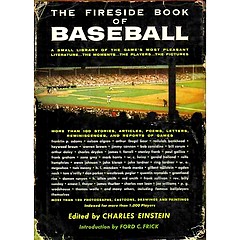I’m not a big sports fan. I stopped watching baseball after the 1975 World Series. I used to leave college football games in the fourth quarter when I worked them as an usher. My sons and I followed the San Antonio Spurs to their NBA championship in 1999, but that had a lot to do with living in the city and having access to cheap tickets. And I’ve attended hundreds of practices, games, and competitions our kids have participated in over the last dozen years. But years will go by before I even glance at a sports page or a game on TV.
I’ve always enjoyed sports writing, though, especially about baseball. I’ve read a couple dozen memoirs of players, such as Paul Hemphill’s Heart of the Game: The Education of a Minor League Ball Player, and many of the “literary” meditations on the game, such as Donald Hall’s wonderful Dock Ellis in the Country of Baseball
and Joel Oppenheimer’s loving account of the 1972 Mets, The Wrong Season
.
 I think it was in the long-gone Filippi’s Books in Seattle that I came across the The Fireside Book of Baseball
I think it was in the long-gone Filippi’s Books in Seattle that I came across the The Fireside Book of Baseball, a collection edited by Charles Einstein first published in 1956. It’s a big magazine-sized volume with nearly 400 pages of prose, poetry, photos and illustrations from the first 100 years of American baseball, and it’s a goldmine for any fan of good writing on baseball.
Most of the good pieces of fiction and nonfiction writing on baseball published up to that time can be found between its covers–Ring Lardner, Red Smith, Branch Rickey, John Tunis, Heywood Broun, Zane Grey (yes, he wrote more than westerns), Bob Considine, Arnold Hano, and of course, Ernest Thayer. Some of the pieces were reprints; others were originals. In between the articles and stories are wonderful photos of plays and players, artifacts, mementos, and other hits of baseball lore. At the very least the pieces are all good, most of them vivid and lively, and some great. As Einstein later recalled,
It got enormous reviews. I mean, not just in terms of acclaim, but also in terms of where the reviews appeared: John Chamberlain with a full column in the Wall Street Journal; Charles Poore, the entire daily review of the New York Times; the Sunday book review section of the New York Times; so forth and so on.
Baseball even paid an unintended tribute to the book: its publication date, 8 October 1956, was also the day that Don Larsen pitched the one and only perfect game in a World Series (to date). The response from readers was also good, far exceeding Simon and Schuster’s expectations, and they hired Einstein to put together The Second Fireside Book of Baseball two years later. It included one of the best demonstrations of respect from the players themselves–an introduction by Ted Williams, still taking the field back then.
Ten years later, Einstein compiled The Third Fireside Book of Baseball. This might be the best of the three, since it had the advantage of pulling from both the classics and a new generation of sports writers, which included Roger Angell, Jimmy Breslin, William Price Fox, George Plimpton, and even John Updike.
Nearly twenty years after that, Simon and Schuster released the last of the series, confusingly titled The Fireside Book of Baseball, Fourth Edition. Whoever came up with that bright idea would probably have argued that Colonel Sanders should call his restaurants Hot Dead Chicken. Einstein himself considered it the best of the four in terms of content:
… I think the fourth Fireside Book of Baseball is the best of the four, I really do … certainly in terms of the fiction and poetry. Each book as a strength, and in the fourth I think the fiction is just stunning. Because there had been 19 years since the third book and there’d been an accumulation of great stuff: Chaim Potok’s chapter from The Chosen on that softball game; and that long section from Will Kennedy’s Inronweed on the guy who played third base for the Senators; and that ballgame in the insane asylum from Philip Roth’s The Great American Novel. You read this stuff and your mouth just drops open. And Robert Coover and Irwin Shaw and on and on, one great piece after another.
The packaging, on the other hand, Einstein compared to “a Crazy Eddie catalog.”
Taken together, the four books truly represent, as The Ultimate Baseball Book (itself a pretty fine anthology) called it, “baseball literature’s finest monument.” Einstein himself twice culled from the books to produce yet more anthologies–The Baseball reader: Favorites from the Fireside books of baseball
–and The New Baseball Reader: More Favorites from The Fireside Books of Baseball
. A prolific writer, Einstein also contributed one of baseball’s better novels–The Only Game in Town
–and one of its better biographies, Willie’s Time
, from 1979.
 Simon and Schuster published at least seven other Fireside books on sports and games, including:
Simon and Schuster published at least seven other Fireside books on sports and games, including:
- The Fireside Book of Chess
, edited by Irving Chernov & Fred Reinfeld (1949)
- The Fireside Book of Cards
, edited by Oswald Jacoby & Albert Morehead (1957)
- The Fireside Book of Fishing
, edited by Raymond Camp (1959)
- The Fireside Book of Boxing
, edited by W. C. Heinz (1961)
- The Fireside Book of Football
, edited by Jack Newcombe (1964)
- Fireside Book of Horse Racing
, edited by David F. Woods, 1964
- The Fireside Book of Tennis
, edited by Allison Danzig & Peter Schwed (1972)
